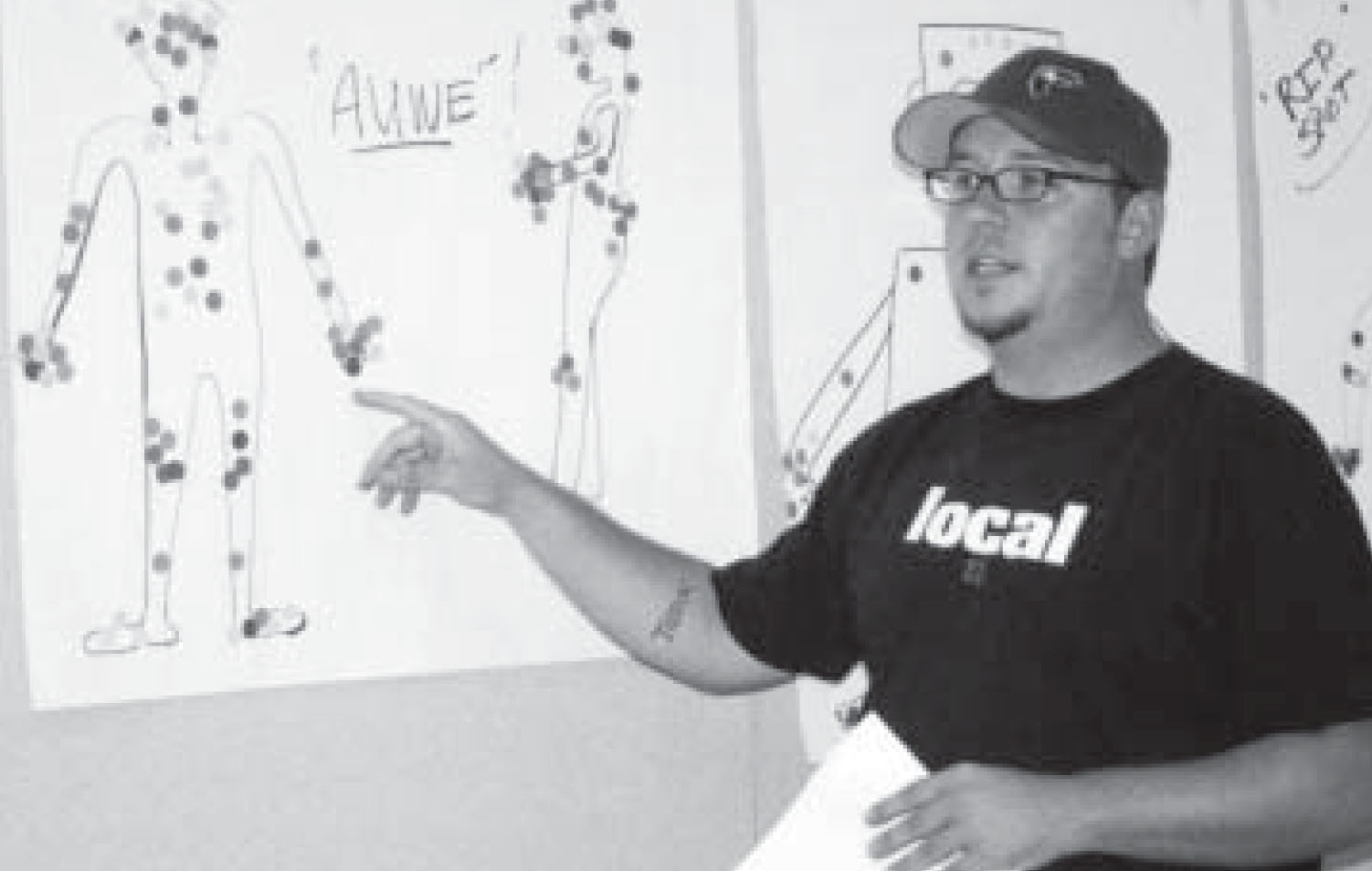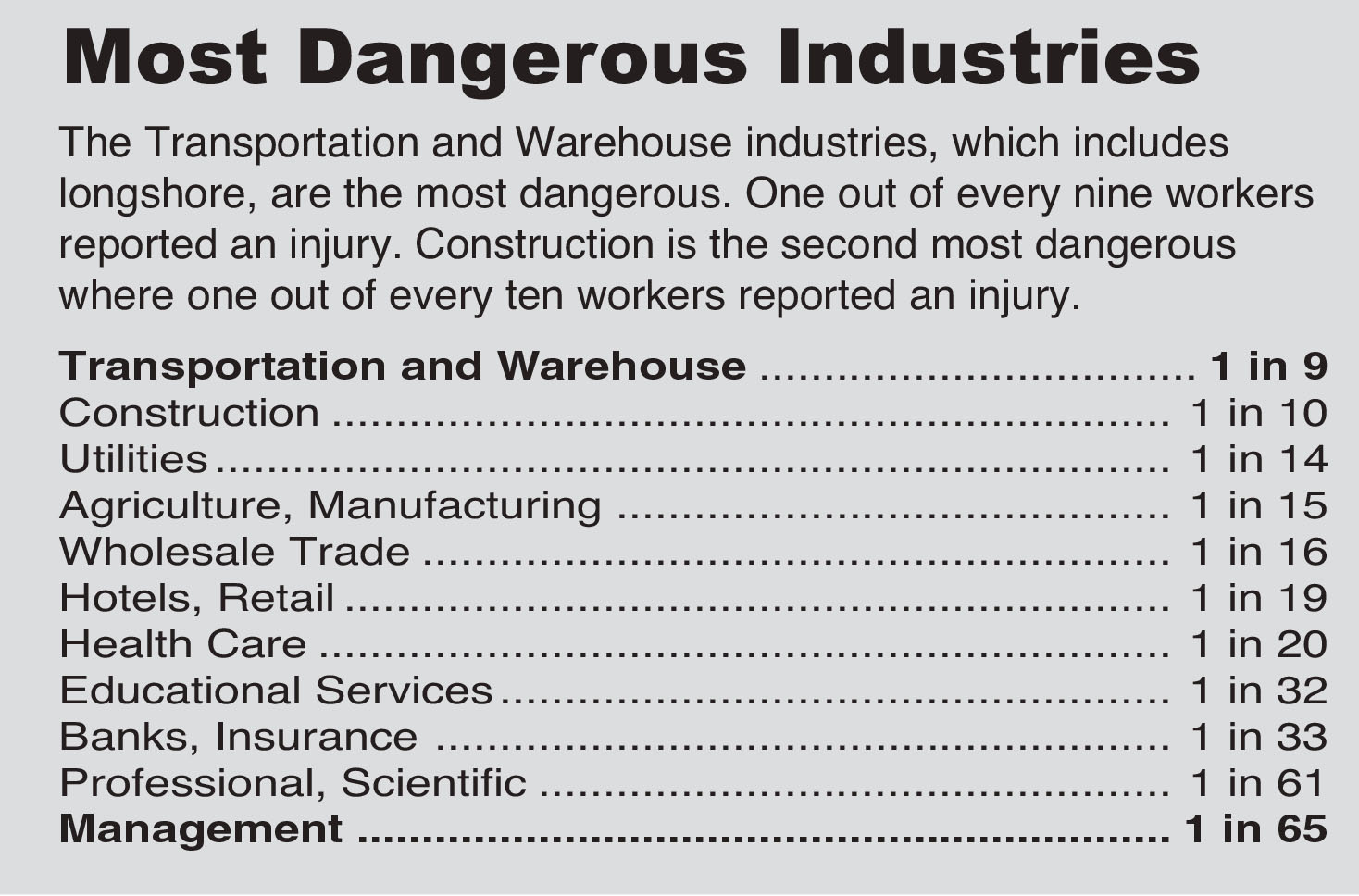You then look for patterns. A worker may think difficulty breathing or a skin rash are due to their personal health condition. A body mapping exercise may show that several workers in a particular department have the same difficulty breathing or workers who use a particular cleanser have the same skin rash. Such patterns of similar injuries usually point to a workplace hazard that needs to be eliminated.
Unionized workers can and should play a big role in insuring that their employers provide a safe workplace. Workers can use mapping to do their own analysis of workplace hazards. They can demand that management bar-
gain with the union over workplace safety policies and program. And unionized workers can push for real safety by eliminating hazards and putting an end to management BS programs that blame the worker or over reliance on ineffective personal protective devices. ◆

Ron Walzer of Unit 1520 - Sheraton Keauhou Bay Resort & Spa points out patterns of injuries during his class on workplace safety at the 7th ILWU Labor Institute held July 2005 at the Local office in Honolulu.
Personal safety gear least effective 5 ways to control workplace hazards
Elimination
The best way to control a hazard is to eliminate it and remove the danger. This can be done by changing a work process in a way that will get rid of a hazard; substituting a non-toxic chemical for a toxic substance; having workers perform tasks at ground level rather than working at heights; implementing needle-less IV systems in health care facilities to eliminate needles; and other methods that remove the hazard altogether.
Substitution
The second best way to control a hazard is to substitute something else in its place that would be non-hazardous or less hazardous to workers. For example, a nontoxic (or less toxic) chemical could be substituted for a hazardous one.
Engineering Controls (Safeguarding Technology)
If a hazard cannot be eliminated or a safer substitute cannot be found, the next best approach is to use engineering controls to keep the hazard from reaching the worker. This could include methods such as using noise dampening technology to reduce noise levels; enclosing a chemical process in a Plexiglas “glove box”; using needles that retract after use; using mechanical lifting devices; or using local exhaust ventilation that captures and carries away the contaminants before they can get in the breathing zone of workers.

Administrative Controls (Training and Procedures)
If engineering controls cannot be implemented, or cannot be implemented right away, administrative controls should be considered. Administrative controls involve changes in workplace policies and procedures. They can include such things as: Warning alarms; Labeling systems; Reducing the time workers are exposed to a hazard, and Training.
For example, workers could be rotated out of a hot area rather than spend eight hours per day in the heat. Back-up alarms on trucks are an example of effective warning systems. However, warning signs used instead of correcting a hazard that can and should be corrected are not acceptable forms of hazard control. For example, it is neither
effective nor acceptable to post warning signs by an unguarded machine cautioning workers to work carefully.
Personal Protective Equipment
The use of personal protective equipment (PPE) is a way of control ing hazards by placing protective equipment directly on workers’ bodies. Examples of personal protective equipment include: respirators, gloves, protective clothing, hard hats, goggles, and ear plugs.
Personal protective equipment is the least effective method for protecting workers from hazards. PPE should be used only while other more effective controls are being developed or installed, or if there are no other more effective ways to control the hazard. This is because:
• The hazard is not eliminated orchanged.
• If the equipment is inadequate or fails, the worker is not protected.
• No personal protective equipment is fool-proof (for example, respirators leak).
• Personal protective equipment is often uncomfortable and can place an additional physical burden on a worker.
• Personal protective equipment can actually create hazards. For example, the use of respirators for long periods of time can put a strain on the heart and lungs.
While there are some jobs, such as removing asbestos, where wearing adequate personal protective equipment is absolutely essential, there are many jobs where employers hand out personal protective equipment instead of using more effective hazard control methods.
A word of caution
When planning for hazard controls, remember that the control selected must not eliminate one hazard while
creating another. For example, it is not acceptable to remove air contaminants from one area by venting them
to another area where another group of workers will be exposed. Hazard control measures should eliminate or
reduce hazards for all who are potentially exposed to them.
Hazard control: whose responsibility?
The ability and responsibility to design jobs safely in the first place, or redesign them when a hazard is detected, lies with management. It is the role of workers and unions to promote the use of the “Hierarchy of Controls,” making sure that employers are providing the most effective methods for hazard control possible. Remember: fix the workplace, not the worker! ◆
[Taken from the Labor Safety and Health Training Project. George Meany Center-National Labor College.]
